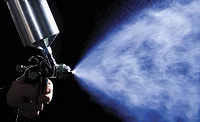Controlling Static: Alternatives to Tinsel

Converters of non-conductive web surfaces, such as pressure sensitive adhesive (PSA) tapes, need to be constantly vigilant in controlling static electricity. High levels of electrostatic charges can be dangerous, and moderate levels can permanently destroy an adhesive system, cause fouling and jamming of production processes and damage to finished products.
New technology allowing faster production speeds exacerbates static-related problems. To reduce static, operators sometimes will intentionally slow down the production process – a costly practice, indeed!

The Cause: Contact and Separation
Static electricity is an accumulation of electrical charges on a surface. The polarity of the charge can be the result of an excess of electrons (negative charge) or a deficiency of electrons (positive charge). Charges accumulate on the surface of non-conductive material such as paper or plastic film, and they can also accumulate on ungrounded conductive materials such as machine parts and the human body.When surfaces are in contact with each other, a transfer of electrons occurs. Friction, pressure and web speed will accelerate this transfer. When separated, the surface that has gained electrons becomes negatively charged, and the mating surface giving up the electrons becomes positively charged.
This process, known as triboelectrification or tribocharging, results in the generation of static charges on the surface of PSA tape as it unwinds from the roll and as it contacts and separates from surfaces such as idler rolls, nip rolls and printing or coating rolls. The build-up of electrostatic charges is a cumulative process, increasing each time the web contacts another surface. PSA tape can therefore accumulate a high charge as it passes through transport systems where it comes in contact with several idlers.
On non-conductive materials, such as the papers and films used for PSA tape, charges do not build up uniformly across the surface. A single contiguous surface may accumulate a positive charge in some regions and a negative charge, or no charge, in other regions. The intensity of charge will also vary dramatically. For example, a positively charged “island” of 30 kV might coexist 12 inches from a positively charged island of only 500 volts and 18 inches from a negatively-charged island of 2.5 kV.
The Impact
We are all familiar with the shock or spark caused by so-called electrostatic discharge (ESD) events. On a small scale, you feel an ESD in the form of a spark when you touch a door knob after walking across a carpet. On a much larger scale, you observe an ESD when lightning storms light up the sky. An ESD occurs when a static electrical field exceeds a certain threshold value, causing an ionized conductive channel to form in the air as Nature’s desire for balance plays out.Personal Safety
An ESD can be painful and cause burns, cardiac problems and even death. In addition to the direct health effects of exposure to electrical current, there is also the secondary hazard of operators suddenly recoiling from the shock and injuring themselves by falling against dangerous machinery.
Explosion and Equipment Damage
Static discharge is a spark. Areas with flammable liquids or gases, such as solvents, must remain spark-free at all times. Electrostatic discharge can have sufficient energy to ignite hazardous vapors in coating heads and gravure printing operations. An ESD event can also disrupt logic in PLCs and sensing equipment causing processing errors and costly down time.
Damage to the Adhesive System
Static buildup and ESD events can damage the PSA release liner of the product being unwound. When the silicone coating is disrupted by static it will no longer function as a release system in the area affected by the discharge. The adhesive will “split” between two sides of release liner. Alternatively, the liner can fail to release where it is damaged, making it very difficult to remove the liner as designed.
Equipment Jams
The accumulation of electrostatic charges can cause problems, even if ESD events do not occur. If static charges are not neutralized, sheets of materials will stick together, creating jams in downstream processes.
Product Damage
Electrostatic fields also attract dust particles, fibers, bugs and hair, which results in surface contamination. This causes obvious quality problems in printing, coating and laminating, as well as cleanliness problems with medical PSA applications. Moreover, static charges can cause uneven coatings and “wicking” of inks, and pressure sensitive tape carrying a static charge can damage sensitive electronic components.
Common Static Control Methods
To control static on coating and converting machines, two general types of ionizers are available – passive ionizers and active ionizers. Passive ionizers, also called induction ionizers and non-permanent static control devices, include static tinsel and static string, which are simply grounded emitters placed parallel and close to the charged material. The electrical energy of the charged material will excite the passive ionizer, causing it to generate air ions of the opposite polarity. If properly positioned, a passive ionizer can successfully reduce the electrostatic charge.Active ionizers (also called permanent static control devices), such as high output static neutralizer bars and static blowers, are powered by an external source of electrical voltage. Alternatively, radioactive material can be used as an ion source. The relatively high purchase cost of active ionizers has limited their use in the converting industry.
Tinsel, also know as garland, is relatively inexpensive and remains one of the most widely used methods for controlling static. However, anti-static tinsel is composed of copper, and pieces of this soft metal can break off and contaminate the product.
Extensive Testing by Adchem Engineers
To address this problem, engineers at Adchem Corporation tested a variety of passive ionizer products to determine whether any of these methods could provide equal or better static control compared to tinsel, without tinsel’s risk of product contamination.Side-by-side evaluations were performed at Adchem’s 200,000 square foot engineering and manufacturing facility in Riverhead, N.Y. Five different passive ionizer products were tested: anti-static tinsel, static elastic, static wire and two types of static string. Each anti-static product was prepared and then installed one after another in static “hot-spots” along the production line.
The static level was measured in a free-space (an ample distance from any rollers) 10 minutes after the start of a production run. Precise measurement of the static charge over a free-span web surface was performed with a hand-held electrostatic field meter.
The testing procedure was repeated for five different PSA products with non-conductive web surfaces composed of a variety of materials.
Superior Performance of "Stop Static" String
The test results showed that alternative passive ionizer methods can provide better static control than tinsel. In fact, one product, the Static String from Stop Static, a division of Alpha Innovation of Marblehead, MA, provided significantly better static control for all five web surfaces tested. The Static String product consistently maintained static levels below the “5000 volts rule” established by Albert E. Seaver in 1993 and generally accepted as the industry safety standard. The Static String product from Alpha Innovation outperformed other passive ionizer products including a similar string product from another manufacturer.An advantage of the Static String product is that it is effective when installed 0.25 to 2.0 inches away from the web. Because it does not need to make contact with the web, it lessens the possibility of web damage, coating damage or contamination. The Static String product also was found to be relatively easy to install and remove, especially compared to tinsel.
Conclusion
When installed correctly, tests at Adchem show that Static String consistently reduced electric charge below the desired level of 5kV in all products tested to date. Adchem has replaced tinsel with Static String on all its coating and converting machines. As a result, the measured static level on all machines has been reduced. Moreover, the Adchem plant has eliminated the risk of product contamination by pieces of copper tinsel. Adchem Corporation can therefore guarantee a higher level of quality control.Looking for a reprint of this article?
From high-res PDFs to custom plaques, order your copy today!






